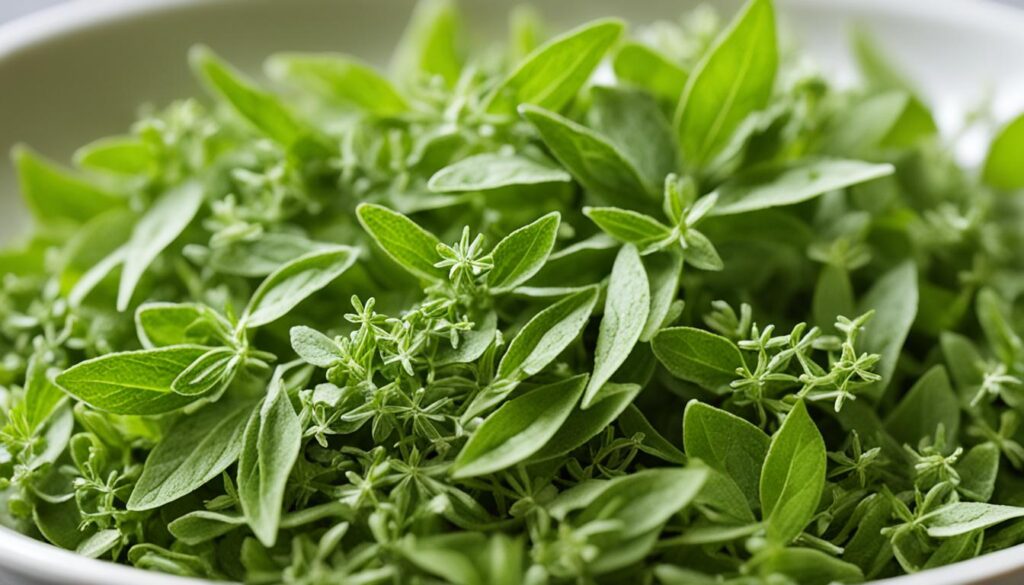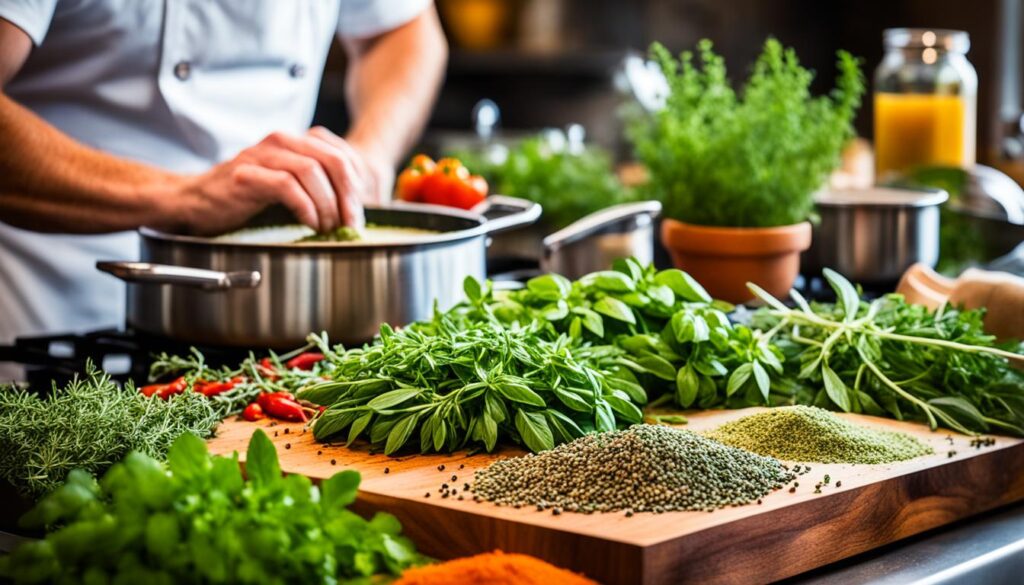Welcome to your guide on oregano. This herb is great for cooking and health. It comes from the Mediterranean and is loved for its taste and health perks.
This guide will show you the many benefits of oregano. We’ll talk about its oils like carvacrol and thymol. These oils fight germs and protect against harm.
Learn how to use oregano in your cooking to make amazing dishes. We’ll share tasty oregano recipes that will wow your guests. Plus, find out how oregano can boost your health.
Stay with us as we explore oregano’s many uses in your life. We’ll make sure you get the most out of this amazing herb.
For tips on growing oregano and other herbs, check out this resource on gardening tools.
What is Oregano? Understanding the Herb
The oregano plant is known as Origanum vulgare. It’s a perennial herb in the mint family, Lamiaceae. This herb is loved for its taste and health perks. Its leaves are oval and can be green or purple.
It also has small white or purple flowers that make gardens look nice.
There are two main types of oregano: Greek and Italian. Greek oregano has a strong taste, perfect for Mediterranean food. Italian oregano is milder and great for Italian dishes, adding a warm flavor to sauces and pizzas.
Oregano grows well in sunny places with good drainage. It’s important in Mediterranean cooking and traditional medicine. People have used it for health reasons for hundreds of years.
Oregano Benefits: Nutritional Powerhouse
Oregano is more than just a tasty herb. It’s packed with nutritional value. It’s full of vitamins and minerals like Vitamin K, manganese, and antioxidants. These help with many oregano health benefits. Adding oregano to your meals can boost your health.
Oregano has strong anti-inflammatory properties. These can help your immune system and fight off bacteria. It shows oregano can be a natural way to stay healthy. When you look into its oregano nutrition, you’ll see it does more than just taste good.
Oregano’s antioxidants protect your cells from harm. It can also help with digestion and fight off germs. This makes it great for cooking, adding flavor and health benefits to your food. Using oregano in your cooking means you’re choosing a food full of nutritional value of oregano.
Culinary Uses of Oregano in Cooking

Oregano is a key ingredient in many dishes, especially in Mediterranean and Mexican food. It adds a strong flavor to sauces and marinades. In Puerto Rican cooking, it’s a must-have for dishes like roast pork shoulder with garlic and sazón.
Fresh oregano tastes milder and smells better than dried oregano. Dried oregano has a stronger taste. To get the best flavor from dried oregano, crush the leaves a bit.
Keep oregano fresh by storing it in the fridge with a damp paper towel. For dried oregano, a cool, dark place is best. Mixing oregano with other spices can make dishes like Puerto Rican stew taste amazing.
Oregano isn’t just for savory dishes. It can also be used in sweet treats like spiced pumpkin cheesecake and empanadas. You can find many oregano recipes online to try new things.
| Dishes Featuring Oregano | Flavor Profile |
|---|---|
| Roast Pork Shoulder | Robust, savory |
| Puerto Rican Stew | Spiced, hearty |
| Marinated Fish (Kingfish Escabeche) | Bright, tangy |
| Plantain Casserole | Comforting, flavorful |
| Red Beans and Rice | Rich, satisfying |
Adding oregano to your cooking makes your dishes taste better and brings a touch of history to the table. If you want to try new recipes, check out culinary applications of oregano. Oregano is a versatile herb that can make your meals special.
Oregano Oil: Therapeutic Properties and Benefits

Oregano oil is known for its health benefits, not just for cooking. It comes from the oregano plant and is full of good stuff. Carvacrol is a key part that fights off germs, viruses, and fungi. This makes oregano oil a key part of natural medicine.
This oil has many therapeutic uses of oregano oil. It fights fungal and bacterial infections. It also has rosmarinic acid, which is an antioxidant. This helps protect against damage from free radicals.
Oregano oil helps your gut by supporting good bacteria. It also reduces inflammation, which helps with healing wounds. It can ease stomach issues, clear up sinus problems, and boost your immune system.
But, it’s important to use oregano oil safely. The right amount depends on what you’re using it for. Always talk to a doctor before using it. Make sure to pick a high-quality oil with at least 70% carvacrol for best results.
Some people might have bad reactions to it. Be careful if you’re allergic, pregnant, breastfeeding, or have bleeding problems. Still, oregano oil is a great choice for natural health.
Oregano Recipes You Will Love

Oregano adds a great taste to many dishes. It’s a top pick in many kitchens. Whether you want to spice up your meals or make classic dishes, oregano can make a big difference.
-
Garlic Oregano Chicken Thighs
This dish is full of flavor. It uses chicken thighs with garlic and oregano. Mix 6-8 chicken thighs with minced garlic, oregano, salt, and pepper. Cooking with oregano brings out the savory taste.
Sear the thighs on medium heat for 5-7 minutes. Then, bake them in a 425°F oven until they hit 165°F inside. This recipe is great for 4 people and is very satisfying.
-
Hearty Beef Marinara
This marinara sauce is rich and perfect for pasta nights. Brown ground beef, then add tomatoes and herbs like oregano. Simmer until it thickens and serve over pasta. This dish shows how oregano can make meals comforting.
-
Fish Tacos with Oregano-Lime Sauce
For a lighter meal, try fish tacos with oregano-lime sauce. Mix lime juice, oregano, and seasoning. Grill fish and serve in warm tortillas. Oregano is great with seafood, making this recipe stand out.
Trying these recipes is a great way to add oregano to your cooking. They focus on flavor and creativity. You can turn your meals into something special. For more ideas, check out this guide to versatile vegetables.
Oregano is great for any meal, whether it’s meat, vegetarian, or seafood. Start your journey with cooking with oregano and enjoy the new flavors it adds to your food.
How to Grow and Harvest Oregano at Home
Growing oregano at home is rewarding and keeps you supplied with this tasty herb. It’s key to know the basics of oregano plant care for success.
First, pick the best spot for your oregano. It loves full sun, needing at least 6 hours of sunlight. Make sure the soil drains well since oregano likes dry conditions. You can grow it in a garden or pots. Use a mix of potting soil and sand for better drainage.
Watering is important when oregano is young. Keep the soil a bit moist but don’t overdo it to prevent root rot. After it gets bigger, oregano can handle drought well. Let the soil dry out between waterings.
When it’s time to harvest oregano, do it just before it flowers. The leaves taste best then. Cut stems with scissors or shears, leaving some leaves to help the plant grow more.
After harvesting, you might want to dry or preserve your oregano. Hang it upside down in a cool, dark spot to dry. Keep the dried leaves in airtight containers for a long time.
Watch out for pests and diseases on your oregano plants. Look for aphids and spider mites. Use natural remedies or insecticidal soap to fight them. Planting marigolds with your oregano can also keep pests away, making your garden healthier.
With the right care, you’ll have fresh oregano all year. It will add a special flavor to your dishes. Plus, you’ll feel proud of growing it yourself.
Exploring Oregano Tea: A Delicious Brew
Oregano tea is a tasty way to enjoy oregano’s health benefits. It’s a favorite among those who care about wellness. Making oregano tea is easy and fun, letting you enjoy its goodness at home.
To make oregano tea, use fresh or dried oregano leaves. Boil water and steep the leaves for 5 to 10 minutes. You can add honey or lemon for extra flavor and health perks.
- Digestive support: Oregano tea can soothe your digestive system and help alleviate uncomfortable symptoms.
- Respiratory health: The natural compounds in oregano may help promote clearer breathing and reduce congestion.
- Rich in antioxidants: Drinking this tea provides a boost of antioxidants that can support overall wellness.
Oregano tea is becoming more popular for good reasons. It’s comforting and has many health benefits. By making oregano tea, you can enjoy a tasty way to add this herb to your life.
| Benefit | Description |
|---|---|
| Digestive Support | Helps alleviate discomfort in the digestive tract. |
| Respiratory Health | May promote clearer breathing and reduce congestion. |
| Antioxidants | Offers a rich source of antioxidants for overall health support. |
Oregano Health Benefits: A Natural Remedy
Oregano is a top choice for both cooking and herbal medicine. It has been used for centuries because of its health benefits. It helps with breathing problems, stomach issues, and skin conditions.
Oregano health benefits include fighting off bad bacteria and fungi. Oregano oil is known for its power against harmful germs. This makes it a key part of natural remedies. It boosts your immune system and helps your body fight off sickness.
Oregano is great for your stomach too. It helps make more bile and digestive enzymes. This means better nutrient absorption and less stomach trouble.
For your lungs, oregano is a big help. It reduces swelling and can ease cold and allergy symptoms. Many people drink oregano tea to feel better when they’re sick.
Oregano also has antioxidants that fight off harmful free radicals. This can help prevent diseases and keep you healthy. Its use in herbal medicine shows its value in boosting wellness.
Finding the Right Oregano Substitute in Recipes
Ever found yourself cooking without oregano? Knowing the right substitute can save your dish. Marjoram is a great choice because it tastes similar but is a bit sweeter. Thyme is another option, adding an earthy flavor but changing the dish’s taste a bit.
Italian seasoning is also a good pick if you’re feeling bold. It mixes many herbs, including oregano. This gives a full flavor that’s close to the original. Just remember, some substitutes are stronger than oregano, so adjust the amount you use.
For more cooking ideas or to add chickpeas to your meals, check out this chickpea pasta salad recipe. It’s a tasty mix of fresh ingredients that can take different substitutes well. With these tips, you’ll always have a plan B in the kitchen!



